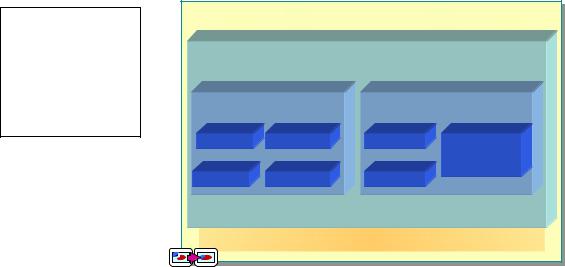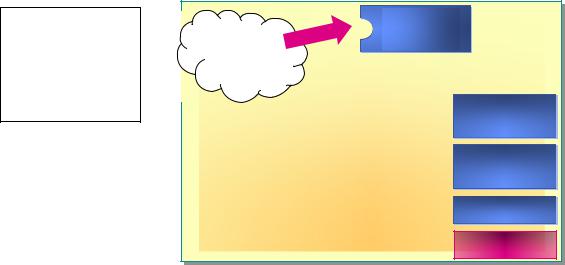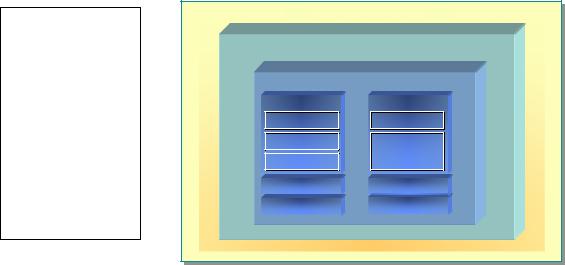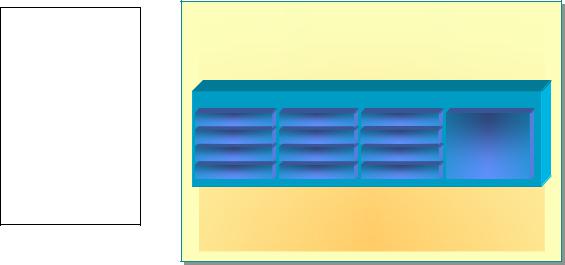
C# ПІДРУЧНИКИ / c# / MS Press - Msdn Training Programming Net Framework With C#
.pdf
Module 1: Overview of the Microsoft .NET Framework |
7 |
|
|
|
|
The .NET Framework Class Library
Topic Objective
To provide an overview of the .NET Framework class library and the most common namespace:
System.
Lead-in
In this topic, you will learn how .NET Framework class library exposes features of the runtime and provides other high-level services.
!Spans All Programming Languages
#Enables cross-language inheritance and debugging
#Integrates well with tools
!Is Object-Oriented and Consistent
#Enhances developer productivity by reducing the number of APIs to learn
!Has a Built-In Common Type System
!Is Extensible
#Makes it easy to add or modify framework features
!Is Secure
#Allows creation of secure applications
*****************************ILLEGAL FOR NON-TRAINER USE******************************
The .NET Framework class library exposes features of the runtime and provides other high-level services that every developer needs.
Because there are hundreds of classes in the .NET Framework class library, classes are grouped into namespaces. The first part of the full name, which is located before the rightmost dot, is the namespace name. The last part of the name, which is located after the dot, is the type name.
For example, System.Collections.ArrayList represents the ArrayList class, which belongs to the System.Collections namespace. The types in System.Collections namespace can be used to manipulate collections of objects.
Spans All Programming Languages
The .NET Framework class library is language-independent so it enables crosslanguage inheritance and debugging. The .NET Framework class library also integrates fully with Microsoft Visual Studio® .NET, making it easy to develop applications with the library.
Is Object-Oriented and Consistent
Unlike flat APIs that are numerous and unorganized, the .NET Framework class library is organized into namespaces and classes. This object-oriented approach groups related functionality and data together and enables the developer to work with the library in a more natural way.

8Module 1: Overview of the Microsoft .NET Framework
Has a Built-In Common Type System
The .NET Framework class library is type-safe. Type safety is ensured through the common type system, which is part of the common language runtime.
Is Extensible
You can extend the library by creating your own classes and compiling them into libraries. If designed properly, your class library will also be objectoriented and language-independent.
Is Secure
The .NET Framework class library provides rich security for your applications. You can use code access security and role-based security, and configure your own security policies. Furthermore, there are numerous security tools to assist in certificate creation, permission viewing, and so on.

Module 1: Overview of the Microsoft .NET Framework |
9 |
|
|
|
|
ADO.NET: Data and XML
Topic Objective
To explain the data and XML support in the runtime.
Lead-in
The .NET Framework provides a new set of ADO.NET classes to handle data.
|
ADO.NET: Data and XML |
|
System.Data |
System.Xml |
|
OleDb |
SqlClient |
XSL |
|
|
Serialization |
Common |
SQLTypes |
XPath |
*****************************ILLEGAL FOR NON-TRAINER USE******************************
ADO.NET, the next generation of ADO technology provides improved support for disconnected programming. It also provides rich XML support in the
System.Xml namespace.
System.Data Namespace
The System.Data namespace consists of classes that constitute the ADO.NET object model. At a high level, the ADO.NET object model is divided into two layers: the connected layer and the disconnected layer.
The System.Data namespace includes the DataSet class, which represents multiple tables and their relations. These data sets are completely self-contained data structures that can be populated from a variety of data sources. One data source could be XML; another data source could be an OLE DB; and a third data source could be the direct adapter for Microsoft SQL Server™.
System.Xml Namespace
The System.Xml namespace provides support for XML. It includes an XML parser and a writer, which are W3C-compliant. The Extensible Stylesheet Language for Transformation (XSLT) is provided by the System.Xml.Xsl namespace. The implementation of XPath, a comprehensive language for document addressing, enables data graph navigation in XML. The System.Xml.Serialization namespace provides the entire core infrastructure for XML Web services, including such features as moving back and forth from objects to an XML representation.

10 |
Module 1: Overview of the Microsoft .NET Framework |
What Is an XML Web Service?
Topic Objective
To define an XML Web service.
Lead-in
XML Web services are the fundamental building blocks of the .NET platform.
Open |
XML Web |
|
service |
||
Internet |
||
A programmable application component |
||
Protocols |
||
|
accessible via standard Web protocols |
!Provide a Directory of Services on the Internet
!XML Web services are defined in terms of the formats and ordering of messages
!XML Web services consumers can send and receive messages using XML
!Built using open Internet protocols
UDDI
Universal Description,
Discovery, and Integration
WSDL
Web Services
Description Language
SOAP
XML & HTTP
*****************************ILLEGAL FOR NON-TRAINER USE******************************
XML Web services are an integral part of the .NET platform. They are the fundamental mechanism for exposing and consuming data and functionality across Web applications, both inside organizations and across organizations.
XML Web services are units of application logic that provide data and services to other applications. Applications access XML Web services by means of industry standard Web protocols and data formats, such as HTTP, XML, and Simple Object Access Protocol (SOAP), regardless of how each XML Web service is implemented.
XML and HTTP
XML Web services are built by using XML and HTTP. Because they are built with XML and HTTP, XML Web services operate without firewall restrictions. Also, because XML and HTTP are industry standards, any platform supporting XML and HTTP can work with XML Web services.
SOAP
SOAP defines how messages are formatted, sent, and received when working with XML Web services. SOAP is also an industry standard that is built on XML and HTTP. Any platform that supports the SOAP standard can support XML Web services.
Module 1: Overview of the Microsoft .NET Framework |
11 |
|
|
|
|
Web Services Description Language
The Web Services Description Language (WSDL) is an XML format for describing the network services that are offered by the server. You use WSDL to create a file that identifies the services that are provided by the server and the set of operations within each service that the server supports. For each of the operations, the WSDL file also describes the format that the client must follow when requesting an operation.
Universal Description, Discovery, and Integration
Universal Description, Discovery, and Integration (UDDI) is an industry standard for registering and searching for XML Web services. By using UDDI, developers can discover and use XML Web services that are available publicly over the Internet.
For more information on UDDI, see Web Service Discovery in Module 13, “Remoting and XML Web Services,” in Course 2349B, Programming with the Microsoft.NET Framework (Microsoft Visual C# .NET), and the UDDI Web site at http://www.uddi.org.

12 |
Module 1: Overview of the Microsoft .NET Framework |
Web Forms and Services
Topic Objective
To show where Web Forms and XML Web services are found in the ASP.NET programming model.
Lead-in
The Internet is quickly evolving from today’s Web sites that simply deliver UI pages to browsers to a next generation of programmable Web sites that link organizations, applications, services, and devices directly.
|
ASP.NET |
|
System.Web |
Services |
UI |
Description |
HtmlControls |
Discovery |
WebControls |
Protocols |
|
Caching |
Security |
Configuration |
SessionState |
*****************************ILLEGAL FOR NON-TRAINER USE******************************
ASP.NET is a programming framework built on the common language runtime that can be used on a server to build powerful Web applications. ASP.NET Web Forms provide an easy and powerful way to build dynamic Web UI pages. ASP.NET XML Web services provide the building blocks for constructing distributed Web-based applications. XML Web services are based on open Internet standards, such as HTTP and XML.
The common language runtime provides built-in support for creating and exposing XML Web services by using a programming abstraction that is consistent and familiar to both ASP Web Forms and Visual Basic developers. The resulting model is both scalable and extensible. This model is based on open Internet standards, such as HTTP, XML, SOAP, and WSDL, so it can be accessed and interpreted by any client or Internet-enabled device. Some of the more common ASP.NET classes are described in this topic as follows:
System.Web
In the System.Web namespace, there are lower-level services, such as caching, security, and configuration, which are shared between XML Web services and Web UIs.
System.Web.Services
The System.Web.Services namespace has classes that handle XML Web services, such as protocols and discovery.
Controls
There are two types of controls: HTML controls and Web controls. The System.Web.UI.HtmlControls namespace gives you direct mapping of HTML tags, such as input. The System.Web.UI.WebControls namespace enables you to structure controls with templates, such as grid controls.

Module 1: Overview of the Microsoft .NET Framework |
13 |
|
|
|
|
" Overview of Namespaces
Topic Objective
To provide an overview of the namespaces in the .NET Framework.
Lead-in
In this section, you will learn about the namespaces in the .NET Framework.
!Namespaces
!Namespaces Used in this Course
!Namespaces Covered in Optional Modules
*****************************ILLEGAL FOR NON-TRAINER USE******************************
In this section, you will learn about the namespaces in the Microsoft .NET Framework. You will also learn about which namespaces are taught in this course.
This section includes the following topics:
!Namespaces
!Namespaces Used in this Course
!Namespaces Covered in Optional Modules

14 |
Module 1: Overview of the Microsoft .NET Framework |
Namespaces
Topic Objective
To understand how namespaces provide an easy-to-use hierarchy of types and functionality.
Lead-in
The .NET Framework includes a large set of class library assemblies, which contain hundreds of types. These assemblies provide access to system functionality in your development process.
System
Collections |
IO |
Security |
Runtime |
Configuration |
Net |
ServiceProcess |
|
Diagnostics |
Reflection |
Text |
|
Globalization |
Resources |
Threading |
|
*****************************ILLEGAL FOR NON-TRAINER USE******************************
The .NET Framework includes a large set of class library assemblies, which contain hundreds of types. These assemblies provide access to system functionality in your development process.
The Purpose of Namespaces
Because the .NET Framework class library includes definitions for so many types, the library is organized in a hierarchical namespace structure.
Namespaces use a dot-syntax naming scheme to group logically related classes together so that they can be easily searched and referenced. For example, the System.Data namespace contains the classes that constitute the ADO.NET architecture. The System.Xml namespace is the overall namespace for the XML classes that provide standards-based support for processing XML.
The System Namespace
The System namespace is the root namespace for types in the .NET Framework. The System namespace contains the base type Object, from which all other types are derived.
The System namespace also contains types for exception handling, garbage collection, console I/O, various tool types, format data types, random number generators, and math functions.

Module 1: Overview of the Microsoft .NET Framework |
15 |
|
|
|
|
Namespaces Used in this Course
Topic Objective
To explain which namespaces are taught in this course, and which namespaces are not taught.
Lead-in
This course covers many of the System namespaces. Not all namespaces are covered, for example the
System.Security
namespaces.
|
Module 2 |
|
Module 10 |
||
|
|
||||
|
# |
System.Console |
|
# |
System.IO |
|
Module 3 |
|
Module 11 |
||
|
|
|
System.Net |
||
|
# |
System.Windows.Forms |
|
# |
|
|
|
|
System.Net.Sockets |
||
|
# |
System.Drawing |
|
# |
|
|
|
Module 12 |
|||
|
Module 4 |
|
|||
|
|
|
System.Runtime.Serialization |
||
|
|
System.Reflection |
|
# |
|
|
# |
|
Module 13 |
||
|
Module 7 |
|
|||
|
|
# |
System.Runtime.Remoting.Channels |
||
|
|
System.Text |
|
||
|
# |
|
# |
System.Web.Services |
|
|
|
System.Collections |
|
||
|
# |
|
|
|
|
|
|
|
|
|
|
|
|
|
|
|
|
*****************************ILLEGAL FOR NON-TRAINER USE******************************
This course covers many of the namespaces in the Microsoft .NET Framework. Module 2 teaches the System.Console namespace for printing output to the console. Module 3 teaches the System.Windows.Forms and System.Drawing namespaces for building a form with buttons that interacts with the user.
Module 4 teaches the System.Reflection namespace for storing version and key file information in an assembly. Module 7 teaches the System.Text namespace for advanced string management, and System.Collections for maintaining collections of data.
Module 10 teaches the System.IO namespace for reading and writing to files. Module 11 teaches the System.Net and System.Net.Sockets namespaces for transmitting data over the network.
Module 12 teaches the System.Runtime.Serialization namespace for persisting objects to storage. Module 13 teaches the
System.Runtime.Remoting.Channels and System.Web.Services namespaces for invoking remote objects, and building XML Web services.

16 |
Module 1: Overview of the Microsoft .NET Framework |
Namespaces Covered in Optional Modules
Topic Objective
To complete the namespace information that was presented in the preceding slide.
Lead-in
Here are some more namespaces that are covered in optional Modules 14 through 17 of this course.
Module 14
#System.Threading
Module 16
#System.Data
Module 17
#System.Reflection
*****************************ILLEGAL FOR NON-TRAINER USE******************************
Modules 14 through 17 are optional modules.
Module 14 teaches the System.Threading namespace for enabling multithreaded programming. Module 16 teaches the System.Data namespace, which provides the base objects and types for the ADO.NET programming model. ADO.NET also provides rich XML support in the System.Xml namespace. Finally, Module 17 teaches the System.Reflection namespace, which contains classes that you can use for examining metadata.
Namespaces Not Covered
This course does not teach the System.Security namespace. For more information about System.Security and related security namespaces, see Course 2350A, Securing and Deploying Microsoft .NET Assemblies.
